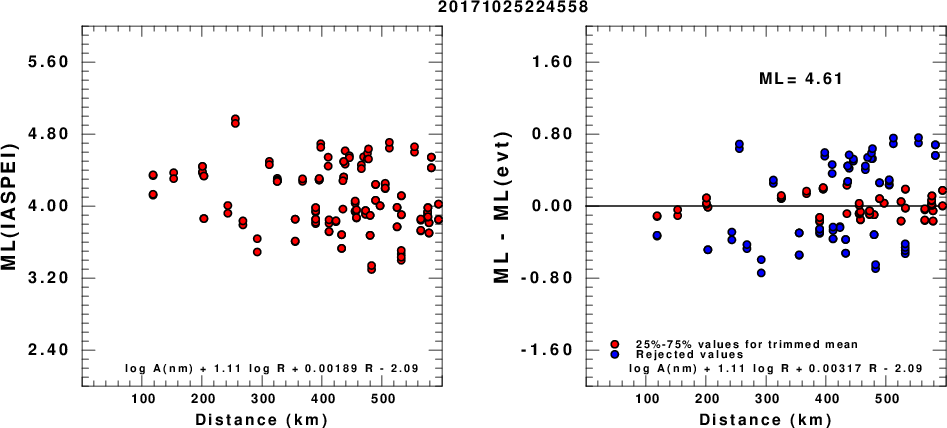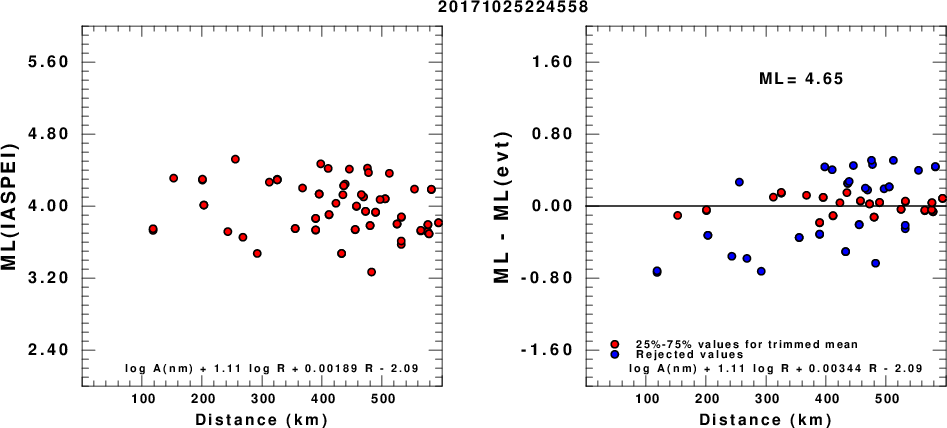Location
Location ANSS
2017/10/25 22:45:58 43.71 17.52 2 4.2 Bosnia Herzegovina
Focal Mechanism
USGS/SLU Moment Tensor Solution
ENS 2017/10/25 22:45:58:7 43.71 17.52 2.0 4.2 Bosnia Herzegovina
Stations used:
AC.BCI AC.KBN HT.FNA HT.HORT HT.KNT HU.BEHE HU.KOVH HU.MORH
MN.BLY MN.BZS MN.DIVS MN.PDG MN.TIR MN.TRI MN.VTS OE.ARSA
OE.KBA OX.ACOM OX.CLUD OX.DRE OX.FUSE OX.PRED OX.SABO
RO.DEV RO.GZR RO.HERR RO.LOT RO.MDVR RO.PUNG SJ.BBLS
SJ.FRGS
Filtering commands used:
cut o DIST/3.3 -30 o DIST/3.3 +70
rtr
taper w 0.1
hp c 0.02 n 3
lp c 0.06 n 3
Best Fitting Double Couple
Mo = 1.97e+22 dyne-cm
Mw = 4.13
Z = 13 km
Plane Strike Dip Rake
NP1 348 69 -148
NP2 245 60 -25
Principal Axes:
Axis Value Plunge Azimuth
T 1.97e+22 5 115
N 0.00e+00 52 18
P -1.97e+22 38 209
Moment Tensor: (dyne-cm)
Component Value
Mxx -5.93e+21
Mxy -1.27e+22
Mxz 7.55e+21
Myy 1.31e+22
Myz 6.34e+21
Mzz -7.22e+21
####----------
#########-------------
##############--------------
################--------------
###################---------------
#####################------####-----
###################---################
################--------################
#############-----------################
###########---------------################
#########-----------------################
#######--------------------###############
#####----------------------###############
###-----------------------##############
##------------------------########## #
-------------------------########## T
---------- -----------##########
--------- P -----------###########
------- -----------#########
--------------------########
----------------######
------------##
Global CMT Convention Moment Tensor:
R T P
-7.22e+21 7.55e+21 -6.34e+21
7.55e+21 -5.93e+21 1.27e+22
-6.34e+21 1.27e+22 1.31e+22
Details of the solution is found at
http://www.eas.slu.edu/eqc/eqc_mt/MECH.NA/20171025224558/index.html
|
Preferred Solution
The preferred solution from an analysis of the surface-wave spectral amplitude radiation pattern, waveform inversion and first motion observations is
STK = 245
DIP = 60
RAKE = -25
MW = 4.13
HS = 13.0
The NDK file is 20171025224558.ndk
The waveform inversion is preferred.
Moment Tensor Comparison
The following compares this source inversion to others
| SLU |
USGS/SLU Moment Tensor Solution
ENS 2017/10/25 22:45:58:7 43.71 17.52 2.0 4.2 Bosnia Herzegovina
Stations used:
AC.BCI AC.KBN HT.FNA HT.HORT HT.KNT HU.BEHE HU.KOVH HU.MORH
MN.BLY MN.BZS MN.DIVS MN.PDG MN.TIR MN.TRI MN.VTS OE.ARSA
OE.KBA OX.ACOM OX.CLUD OX.DRE OX.FUSE OX.PRED OX.SABO
RO.DEV RO.GZR RO.HERR RO.LOT RO.MDVR RO.PUNG SJ.BBLS
SJ.FRGS
Filtering commands used:
cut o DIST/3.3 -30 o DIST/3.3 +70
rtr
taper w 0.1
hp c 0.02 n 3
lp c 0.06 n 3
Best Fitting Double Couple
Mo = 1.97e+22 dyne-cm
Mw = 4.13
Z = 13 km
Plane Strike Dip Rake
NP1 348 69 -148
NP2 245 60 -25
Principal Axes:
Axis Value Plunge Azimuth
T 1.97e+22 5 115
N 0.00e+00 52 18
P -1.97e+22 38 209
Moment Tensor: (dyne-cm)
Component Value
Mxx -5.93e+21
Mxy -1.27e+22
Mxz 7.55e+21
Myy 1.31e+22
Myz 6.34e+21
Mzz -7.22e+21
####----------
#########-------------
##############--------------
################--------------
###################---------------
#####################------####-----
###################---################
################--------################
#############-----------################
###########---------------################
#########-----------------################
#######--------------------###############
#####----------------------###############
###-----------------------##############
##------------------------########## #
-------------------------########## T
---------- -----------##########
--------- P -----------###########
------- -----------#########
--------------------########
----------------######
------------##
Global CMT Convention Moment Tensor:
R T P
-7.22e+21 7.55e+21 -6.34e+21
7.55e+21 -5.93e+21 1.27e+22
-6.34e+21 1.27e+22 1.31e+22
Details of the solution is found at
http://www.eas.slu.edu/eqc/eqc_mt/MECH.NA/20171025224558/index.html
|
Magnitudes
ML Magnitude

(a) ML computed using the IASPEI formula for Horizontal components; (b) ML residuals computed using a modified IASPEI formula that accounts for path specific attenuation; the values used for the trimmed mean are indicated. The ML relation used for each figure is given at the bottom of each plot.

(a) ML computed using the IASPEI formula for Vertical components (research); (b) ML residuals computed using a modified IASPEI formula that accounts for path specific attenuation; the values used for the trimmed mean are indicated. The ML relation used for each figure is given at the bottom of each plot.
Context
The next figure presents the focal mechanism for this earthquake (red) in the context of other events (blue) in the SLU Moment Tensor Catalog which are within ± 0.5 degrees of the new event. This comparison is shown in the left panel of the figure. The right panel shows the inferred direction of maximum compressive stress and the type of faulting (green is strike-slip, red is normal, blue is thrust; oblique is shown by a combination of colors).
Waveform Inversion
The focal mechanism was determined using broadband seismic waveforms. The location of the event and the
and stations used for the waveform inversion are shown in the next figure.

|
|
Location of broadband stations used for waveform inversion
|
The program wvfgrd96 was used with good traces observed at short distance to determine the focal mechanism, depth and seismic moment. This technique requires a high quality signal and well determined velocity model for the Green functions. To the extent that these are the quality data, this type of mechanism should be preferred over the radiation pattern technique which requires the separate step of defining the pressure and tension quadrants and the correct strike.
The observed and predicted traces are filtered using the following gsac commands:
cut o DIST/3.3 -30 o DIST/3.3 +70
rtr
taper w 0.1
hp c 0.02 n 3
lp c 0.06 n 3
The results of this grid search from 0.5 to 19 km depth are as follow:
DEPTH STK DIP RAKE MW FIT
WVFGRD96 1.0 65 85 0 3.76 0.3245
WVFGRD96 2.0 60 55 -40 3.94 0.4075
WVFGRD96 3.0 55 50 -45 3.98 0.4334
WVFGRD96 4.0 240 75 -40 3.97 0.4529
WVFGRD96 5.0 245 60 -20 3.98 0.4722
WVFGRD96 6.0 245 60 -25 4.01 0.5022
WVFGRD96 7.0 245 60 -25 4.03 0.5292
WVFGRD96 8.0 245 55 -25 4.07 0.5477
WVFGRD96 9.0 245 55 -25 4.09 0.5652
WVFGRD96 10.0 245 60 -25 4.09 0.5767
WVFGRD96 11.0 245 60 -25 4.11 0.5851
WVFGRD96 12.0 245 60 -25 4.12 0.5896
WVFGRD96 13.0 245 60 -25 4.13 0.5904
WVFGRD96 14.0 250 65 -20 4.13 0.5894
WVFGRD96 15.0 250 65 -20 4.14 0.5874
WVFGRD96 16.0 250 65 -20 4.15 0.5833
WVFGRD96 17.0 250 65 -15 4.16 0.5777
WVFGRD96 18.0 250 70 -15 4.16 0.5723
WVFGRD96 19.0 250 70 -15 4.17 0.5659
WVFGRD96 20.0 250 70 -15 4.18 0.5585
WVFGRD96 21.0 250 70 -15 4.19 0.5498
WVFGRD96 22.0 250 70 -15 4.20 0.5418
WVFGRD96 23.0 250 70 -15 4.20 0.5330
WVFGRD96 24.0 250 70 -15 4.21 0.5241
WVFGRD96 25.0 250 75 -15 4.22 0.5149
WVFGRD96 26.0 250 75 -15 4.22 0.5054
WVFGRD96 27.0 250 75 -15 4.23 0.4955
WVFGRD96 28.0 250 75 -15 4.24 0.4856
WVFGRD96 29.0 250 75 -15 4.24 0.4755
The best solution is
WVFGRD96 13.0 245 60 -25 4.13 0.5904
The mechanism correspond to the best fit is

|
|
Figure 1. Waveform inversion focal mechanism
|
The best fit as a function of depth is given in the following figure:

|
|
Figure 2. Depth sensitivity for waveform mechanism
|
The comparison of the observed and predicted waveforms is given in the next figure. The red traces are the observed and the blue are the predicted.
Each observed-predicted component is plotted to the same scale and peak amplitudes are indicated by the numbers to the left of each trace. A pair of numbers is given in black at the right of each predicted traces. The upper number it the time shift required for maximum correlation between the observed and predicted traces. This time shift is required because the synthetics are not computed at exactly the same distance as the observed and because the velocity model used in the predictions may not be perfect.
A positive time shift indicates that the prediction is too fast and should be delayed to match the observed trace (shift to the right in this figure). A negative value indicates that the prediction is too slow. The lower number gives the percentage of variance reduction to characterize the individual goodness of fit (100% indicates a perfect fit).
The bandpass filter used in the processing and for the display was
cut o DIST/3.3 -30 o DIST/3.3 +70
rtr
taper w 0.1
hp c 0.02 n 3
lp c 0.06 n 3

|
|
Figure 3. Waveform comparison for selected depth
|

|
|
Focal mechanism sensitivity at the preferred depth. The red color indicates a very good fit to thewavefroms.
Each solution is plotted as a vector at a given value of strike and dip with the angle of the vector representing the rake angle, measured, with respect to the upward vertical (N) in the figure.
|
A check on the assumed source location is possible by looking at the time shifts between the observed and predicted traces. The time shifts for waveform matching arise for several reasons:
- The origin time and epicentral distance are incorrect
- The velocity model used for the inversion is incorrect
- The velocity model used to define the P-arrival time is not the
same as the velocity model used for the waveform inversion
(assuming that the initial trace alignment is based on the
P arrival time)
Assuming only a mislocation, the time shifts are fit to a functional form:
Time_shift = A + B cos Azimuth + C Sin Azimuth
The time shifts for this inversion lead to the next figure:

The derived shift in origin time and epicentral coordinates are given at the bottom of the figure.
Discussion
Acknowledgements
Thanks also to the many seismic network operators whose dedication make this effort possible: University of Nevada Reno, University of Alaska, University of Washington, Oregon State University, University of Utah, Montana Bureas of Mines, UC Berkely, Caltech, UC San Diego, Saint Louis University, University of Memphis, Lamont Doherty Earth Observatory, the Iris stations and the Transportable Array of EarthScope.
Velocity Model
The WUS.model used for the waveform synthetic seismograms and for the surface wave eigenfunctions and dispersion is as follows:
MODEL.01
Model after 8 iterations
ISOTROPIC
KGS
FLAT EARTH
1-D
CONSTANT VELOCITY
LINE08
LINE09
LINE10
LINE11
H(KM) VP(KM/S) VS(KM/S) RHO(GM/CC) QP QS ETAP ETAS FREFP FREFS
1.9000 3.4065 2.0089 2.2150 0.302E-02 0.679E-02 0.00 0.00 1.00 1.00
6.1000 5.5445 3.2953 2.6089 0.349E-02 0.784E-02 0.00 0.00 1.00 1.00
13.0000 6.2708 3.7396 2.7812 0.212E-02 0.476E-02 0.00 0.00 1.00 1.00
19.0000 6.4075 3.7680 2.8223 0.111E-02 0.249E-02 0.00 0.00 1.00 1.00
0.0000 7.9000 4.6200 3.2760 0.164E-10 0.370E-10 0.00 0.00 1.00 1.00
Quality Control
Here we tabulate the reasons for not using certain digital data sets
The following stations did not have a valid response files:
Last Changed Fri Oct 27 08:23:11 CDT 2017








